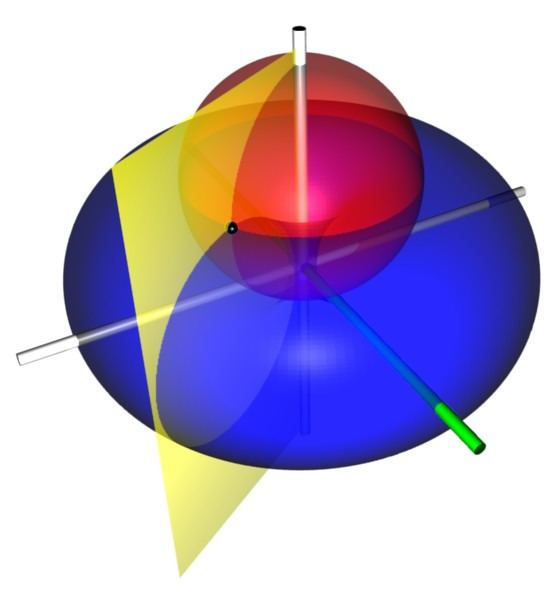 | ||
Toroidal coordinates are a three-dimensional orthogonal coordinate system that results from rotating the two-dimensional bipolar coordinate system about the axis that separates its two foci. Thus, the two foci
Contents
Definition
The most common definition of toroidal coordinates
where the
The coordinate ranges are
Coordinate surfaces
Surfaces of constant
that all pass through the focal ring but are not concentric. The surfaces of constant
that surround the focal ring. The centers of the constant-
Inverse transformation
The (σ, τ, φ) coordinates may be calculated from the Cartesian coordinates (x, y, z) as follows. The azimuthal angle φ is given by the formula
The cylindrical radius ρ of the point P is given by
and its distances to the foci in the plane defined by φ is given by
The coordinate τ equals the natural logarithm of the focal distances
whereas the coordinate σ equals the angle between the rays to the foci, which may be determined from the law of cosines
where the sign of σ is determined by whether the coordinate surface sphere is above or below the x-y plane.
Scale factors
The scale factors for the toroidal coordinates
whereas the azimuthal scale factor equals
Thus, the infinitesimal volume element equals
and the Laplacian is given by
Other differential operators such as
Standard separation
The 3-variable Laplace equation
admits solution via separation of variables in toroidal coordinates. Making the substitution
A separable equation is then obtained. A particular solution obtained by separation of variables is:
where each function is a linear combination of:
Where P and Q are associated Legendre functions of the first and second kind. These Legendre functions are often referred to as toroidal harmonics.
Toroidal harmonics have many interesting properties. If you make a variable substitution
and
where
The classic applications of toroidal coordinates are in solving partial differential equations, e.g., Laplace's equation for which toroidal coordinates allow a separation of variables or the Helmholtz equation, for which toroidal coordinates do not allow a separation of variables. Typical examples would be the electric potential and electric field of a conducting torus, or in the degenerate case, an electric current-ring (Hulme 1982).
An alternative separation
Alternatively, a different substitution may be made (Andrews 2006)
where
Again, a separable equation is obtained. A particular solution obtained by separation of variables is then:
where each function is a linear combination of:
Note that although the toroidal harmonics are used again for the T function, the argument is
